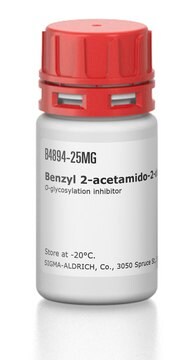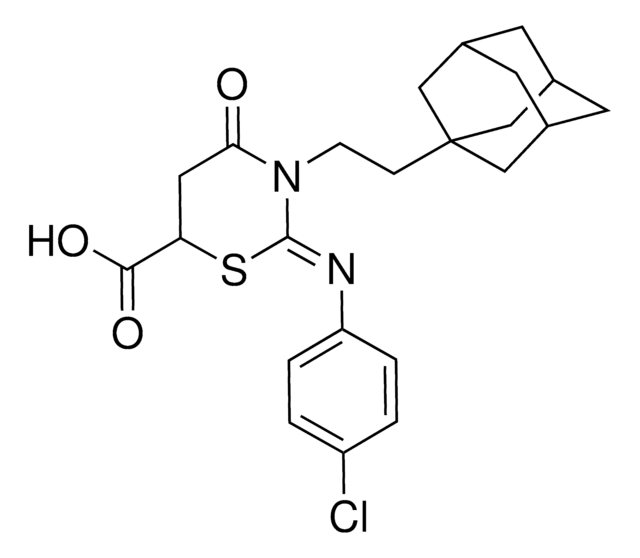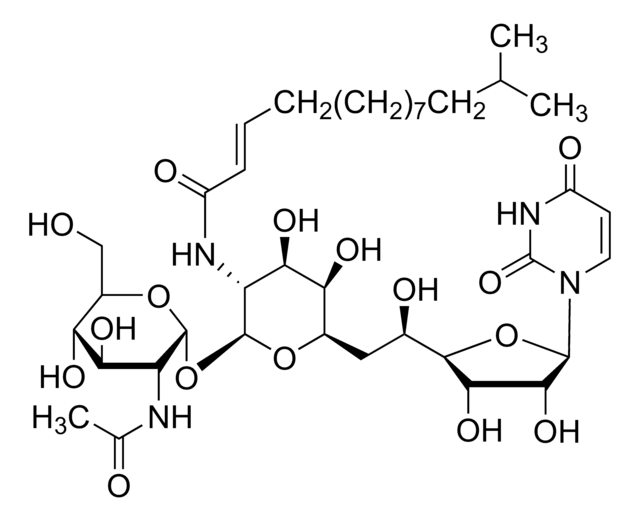T7765
Tunicamycin
from Streptomyces sp., ≥98% (HPLC), powder, N-acetylglucosamine transferase inhibitor
About This Item
Productos recomendados
product name
Tunicamycin from Streptomyces sp.,
Quality Level
solubility
95% ethanol: soluble 1 mg/mL, clear to faintly hazy
THF: soluble <1 mg/mL
dioxane: soluble <1 mg/mL
DMF: soluble >10 mg/mL
pyridine: >10 mg/mL
DMSO: soluble 4.9-5.1 mg/mL, clear to slightly hazy, colorless to yellow
methanol: slightly soluble 4.9-5.1 mg/mL
methanol: soluble 4.9-5.1 mg/mL, clear to slightly hazy, colorless to yellow
acetone: insoluble
aqueous base: insoluble
chloroform: insoluble
ethyl acetate: insoluble
antibiotic activity spectrum
fungi
viruses
mode of action
protein synthesis | interferes
storage temp.
2-8°C
SMILES string
CC(C)CCCCCCCC\C=C\C(=O)N[C@@H]1[C@@H](O)[C@@H](O)[C@@H](C[C@@H](O)[C@H]2O[C@H]([C@H](O)[C@@H]2O)N3C=CC(=O)NC3=O)O[C@H]1O[C@@H]4O[C@@H](CO)[C@H](O)[C@@H](O)[C@@H]4NC(C)=O
InChI
1S/C37H60N4O16/c1-18(2)12-10-8-6-4-5-7-9-11-13-23(45)39-26-30(50)27(47)21(54-36(26)57-35-25(38-19(3)43)29(49)28(48)22(17-42)55-35)16-20(44)33-31(51)32(52)34(56-33)41-15-14-24(46)40-37(41)53/h11,13-15,18,20-22,25-36,42,44,47-52H,4-10,12,16-17H2,1-3H3,(H,38,43)(H,39,45)(H,40,46,53)/b13-11+/t20-,21-,22+,25+,26-,27+,28+,29+,30-,31+,32-,33-,34-,35+,36+/m1/s1
InChI key
YJQCOFNZVFGCAF-WPTOCQRYSA-N
¿Está buscando productos similares? Visita Guía de comparación de productos
General description
Application
Biochem/physiol Actions
Preparation Note
signalword
Danger
hcodes
Hazard Classifications
Acute Tox. 1 Oral
Storage Class
6.1A - Combustible acute toxic Cat. 1 and 2 / very toxic hazardous materials
wgk_germany
WGK 3
flash_point_f
Not applicable
flash_point_c
Not applicable
ppe
Eyeshields, Faceshields, Gloves, type P3 (EN 143) respirator cartridges
Certificados de análisis (COA)
Busque Certificados de análisis (COA) introduciendo el número de lote del producto. Los números de lote se encuentran en la etiqueta del producto después de las palabras «Lot» o «Batch»
¿Ya tiene este producto?
Encuentre la documentación para los productos que ha comprado recientemente en la Biblioteca de documentos.
Artículos
Inhibition of Cell Wall Biosynthesis by Antibiotics
Contenido relacionado
We offer agonists, antagonists, modulators and other bioactive small molecules for immune system signaling target identification and validation, as well as a variety of antibiotics, antivirals, and antifungals.
Nuestro equipo de científicos tiene experiencia en todas las áreas de investigación: Ciencias de la vida, Ciencia de los materiales, Síntesis química, Cromatografía, Analítica y muchas otras.
Póngase en contacto con el Servicio técnico









